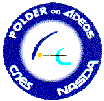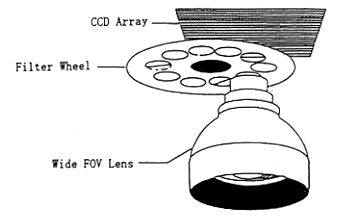
![[Prev Page]](http://www.eorc.nasda.go.jp/images/PrevPage.gif)
![[Next Page]](http://www.eorc.nasda.go.jp/images/NextPage.gif)
![[Top Of
Page]](http://www.eorc.nasda.go.jp/images/TopOfPage.gif)
![[ADEOS Home]](../../images/ADEOS_HomePage.gif)
![[EORC Home]](../../images/EORC_HomePage.gif)
![[Directory]](../../images/Directory.gif)
Polarization and Directionality of the Earth's Reflectances
(POLDER)
provided by CNES
| 
|
Observation Concept
Polarization and Directionality of the Earth's Reflectances (POLDER) is an
optical sensor for observing the surface reflectance in visible and near
infrared bands. The major differences are that POLDER can observe an area from
various directions and the spectral characteristics of the reflected solar
light.

|
| POLDER observation concept
|
POLDER has a wide FOV lens with +/-43 degrees (along the track) x +/-51 degrees
(cross track), and adopts pushbroom technique and an area can be observed from
the maximum 14 different directions. This observation helps understand angular
characteristics of the earth's reflectance. In addition, POLDER can observe
multipolarization in multibands by rotating 16 types of interference filters and
polarizers.
Similar to Total Ozone Monitoring Spectrometer (TOMS), the wide FOV of POLDER
enables the entire earth surface to be scanned four times for 5 days.
Planned Missions
As mentioned above, POLDER can observe the reflectance of a given Earth target
under different spectral, polarization and angular conditions. As a result, the
atmospheric characteristics will be further understood. POLDER will help
understanding the dynamics of the aerosols in the troposphere and the potential
effects of clouds on the radiative balance of the Earth.
Configuration and Function of Sensor
POLDER consists of the optical subsystem and electronics subsystem. The optical
subsystem consists of a telecentric lens, a filter wheel and a CCD array as a
detector.
The light is almost vertically incident on the filter wheel after the
telecentric lens makes the optical correction. The CCD array (244 x 274
elements) can collect two-dimensionnal images. The filter wheel has 16 filters
and is rotated so that 16-channel images are acquired per one rotation.
The main functions of electronics subsystem are to process imagery (eg. A/D
conversion), to handle telemetry/command for operation of the processed image
and POLDER and to control the filter wheel, the electric power and the heat.
![[Prev Page]](http://www.eorc.nasda.go.jp/images/PrevPage.gif)
![[Next Page]](http://www.eorc.nasda.go.jp/images/NextPage.gif)
![[Top Of
Page]](http://www.eorc.nasda.go.jp/images/TopOfPage.gif)
![[ADEOS Home]](../../images/ADEOS_HomePage.gif)
![[EORC Home]](../../images/EORC_HomePage.gif)
![[Directory]](../../images/Directory.gif)
 Earth Observation Research Center
Earth Observation Research Center
Comments to: adeossupport@eorc.nasda.go.jp
Last Update: 5 Febrary 1998




![]() Earth Observation Research Center
Earth Observation Research Center